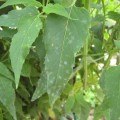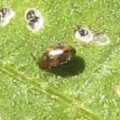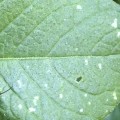Symphylans are very small, white, many segmented organisms that you may see in your soil when you pull up a struggling plant. You will notice them darting and scurrying quickly about the root ball or seedling plug. They are also known as symphlans, or “symphys”, pseudocentipedes, or garden centipedes, even though they are not centipedes. They are very small, but can do a lot of crop damage. Some can consume more than 20 times their own weight in vegetable matter in 24 hours
Physical Description
- 1/4″ long, max
- translucent to milky white
- many segments (up to 14)
- 8-12 pairs of legs
- fragile & delicate – can’t even burrow their own tunnels
- “symph patches” in the soil tend to be round and cover anywhere from 1-2′ to a number of acres
- Google image search
Species & Taxonomy
- Kingdom: Animalia
- Phylum: Arthropoda
- Subphylum: Myriapoda
- Class: Symphyla
- Order:
- Families:
- Scutigerellidae
- Scolopendrellidae
- Genus Species: Scutigerella immaculata
Lifecycle
- usually brought into the soil via manure or compost, so screening compost is important (1/4″ screen)
- Symphs lay clusters of white eggs about a foot down in the soil
- in about 160 days (in 50º F soil), they go from egg to adult
- they prefer soil temps to be at around 65º F
- at least one generation per year, with most adults having two complete broods
- Symphlans feed on decaying matter, but if growing roots are around, they prefer the roots
- They appear to have very long lifespans, up to 5 years in the lab (with no live plant material added)
- they molt throughout their lives; prior to molting, they will leave the root ball and move deeper into the soil and go into a non-feeding stage; this could be in the summer, where it’s very hot.
- they can move about 12″ per day
Plants Affected
Very broad host range, including:
- asparagus
- beans
- beets
- brassicas
- carrot
- celery
- chrysanthemum
- clover
- corn
- cucumber
- lettuce
- melons
- parsley
- peas
- peppers
- potatoes
- spinach
- strawberries
- tomatoes
Plants Unaffected
?
Geographical Range
Common in all parts of the world
Signs & Symptoms
First indication is usually a small area of stunted, unhealthy plants. Maybe an area (or just one plant, in a small garden) where new transplants are not keeping up with others.
Seeds/Germination
- seeds don’t seem to germinate
- germinated seed sprout barely gets out of the ground then dies
Seedlings & Transplants
- stunting, or just not flourishing
Adult Plant
- symphylans are not likely to noticeably injure an adult plant, but they can provide entryways for soil-borne pathogens via the damage where they feed on the roots.
Leaves
Flowers
Fruit
Roots/Tubers
- They feed primarily on root hairs and rootlets, so you will notice little root development
- when freshly pulled up, you may notice the symphylans scurrying around, looking for cover in the soil or seedling plug
- roots will be short & stubby
How to Positively Identify
- for seeds that have failed to germinate, or germinate, then die, scratch the surface, down to the seed. if you find any symphylans in the medium, then they are likely the cause; however, if none are found – and no insect larvae – then it’s likely to be fungal cause
- for seedlings that lag way behind other seedlings, it’s worthwhile to pull up the plug. If symphylans are the cause, there will be hardly anything holding the plug in the ground. Symphylans will be present. They are fast, so keep a keen eye when pulling it up.
- per Mr. Jeavons, of Ecology Action:
- using a shovel, dig up a shovelful of the soil, count symphylans present
- if there are only 3 or 4: no big problem
- if there are more than 7 or 8: problem
- compost that is high in wood content seems to attract symphylans; use a 1/4″ screen to sift the bigger wood and sticks out of the compost before adding to the garden
- using a shovel, dig up a shovelful of the soil, count symphylans present
- from UC IPM’s website:
- Sampling for symphylans is difficult and visible detection of any symphylans often indicates a population large enough to cause economic damage. A sampling plan modified from one developed by researchers at Oregon State has proven very efficient and relatively easy:
- Place thick slices of raw potato on the soil surface at the level at which moisture is clearly visible in the soil. Be careful when removing dry soil from the surface not to disturb the pores in the moist soil to prevent symphylans from reaching the bait. This can be done by raking the dry soil away with a lettuce knife, rather than slicing into the soil with a knife or spade.
- Then cover the bait with a solid plastic dome to protect the bait from drying out while it is allowed to attract symphylans. This plastic dome or cap must be large enough not to cause excessive heating of the area or to accumulate excess condensation. A 6 X 6 inch round white plastic pot with no drainage holes or a styrofoam cup is adequate.
- Leave the bait in place for 24 to 36 hours and then remove the cover to count the symphylans, both on the potato slice and on the soil surface underneath. Count the soil surface first as the symphylans there will quickly hide. If symphylan counts approach 75 per potato slice, complete stand loss may occur. Significant stand loss will occur at lower symphylan populations.
- Sampling for symphylans is difficult and visible detection of any symphylans often indicates a population large enough to cause economic damage. A sampling plan modified from one developed by researchers at Oregon State has proven very efficient and relatively easy:
Treatment
- Flooding has been used to control symphylans in some situations but has been unsuccessful in others. Flooding requires at least 2 to 3 weeks, is more likely to be effective in late spring or summer than in winter, and is probably most effective where there is a high water table. Symphylans may be found more than 3 feet below the soil surface and flooding to this level in many soils is difficult. Even in the best circumstances, flooding will only reduce populations; and they can be expected to increase when conditions are again favorable.
- Soil fumigation can kill populations in the upper soil levels; eventually, however, the soil will be re-infested by populations deeper in the soil
- Infested soil can be treated with insecticides, but their effect is limited because of the symphylan’s ability to migrate deep into the soil. Insecticides may help in giving the plants a chance to establish in a protected zone
- Treat for symphylans just before planting
- Spot treatments may be adequate
Prevention & Control
- Symphylans can be especially difficult to get rid of once they have made a home in the garden, so prevention is key
- Prevent symphylans by carefully examine the roots and soil of plant starts or seedlings for symphylans before planting
- sift compost through 1/4″ screen to remove larger woody matter and not-fully-composted matter
Cultural Controls:
Temperature & Humidity:
Mulching & Cultivation Practices:
- Symphylan damage is generally associated with soils that are high in organic matter content (John Jeavons believes this is specifically high wood matter content) with good soil structure.
- Symphylans do not thrive in either compact soil or sandy soils because these soils do not provide them with adequate tunnels for their movement (symphylans cannot make their own burrows)
- There is some evidence that packing down the soil surface after planting may reduce injury
- Effectiveness of rotations with non-host crops has not been studied enough, but there is some promising studies with certain cover crops reducing their numbers, but not significantly enough
- roto-tilling
- in the spring and fall may reduce their numbers since they are fairly fragile organisms
- then hand-cultivating around plants during the season stirs up the soil and destroys symphylans
- roto-till the upper few inches 2-3 times over a few weeks can really bring the numbers down…do this for another few weeks and you can really make a big dent
- but some believe that roto-tilling does more damage to the predators of symphylans, than to the symphylans, themselves
Natural Enemies & Biological Controls
Lots of things like to eat symphylans, however, little is known about their effect on symphylan populations
Microorganisms:
- various fungi
- beneficial nematodes may be helpful, but in laboratory trials, no reduction in symphs was found
- crab meal, or other forms of chitosan (exoskeleton material) is thought to increase the beneficial microorganimsms; may also reduce harmful fungi
Insects:
- true centipedes
- predatory mites
- predaceous ground beetles
Animals:
Reptiles:
Barriers
Traps
Sprays & Dusts
Sources:
- “Garden Symphlans Infest Willamette Valley Soils: Oregon Tilth Growers Share Strategies”
- UC IPM Website: Garden Symphylans
- Wikipedia: Symphyla





Sifting through 1/4 inch hardware cloth does not exclude these miserable beats…in fact, I think sifting composted tree-trimming mulch and mixing it with my other soil amendments is what brought the horrid little monsters to my garden in the first place.
The 1/4 inch sifted compost has been a disaster all the way around; mixing it into the sand/clay dirt in my yard, in an effort to add “soil organic matter” has resulted in a substrate texture that is much too fine, and dense; too easily compacted, and with insufficient air space, especially during our long rainy season here in Florida.
The dirt in my yard looks much better under the garden paths where I have just piled UN-SIFTED tree trimming mulch, with the varied sizes of wood chips and other debris (as mentioned in the “Eden alternative” sites. I think I’ll start doing what the “Eden” acolytes do…mixing partially composted, but still large-ish wood chips and chunks into my now compacted beds to see if I can un-do some of the damage I’ve already done with the sifted crap.
So…what are all of us organic growers going to do about these darn symphlans? Are our “eating gardens” just doomed now?
There’s no place to “move” or “relocate” one’s garden when one’s whole residential lot is little more than a postage stamp (relative to the expansive acreage found on most commercial farms).
Has anyone found any organic method that actually works to reduce Symphylans (and their damage) to crops on small lots? Anybody else in Florida getting wiped out by these guys?
Has anyone tried putting chickens on infested ground to eat them? Or flamethrowers?
It’d be worth a try on the chickens – although, I don’t think my chickens would bother with them, since they are so small. Termites, which are bigger, are only worthwhile to them because they are so numerous when they are blooming.
As for the flamethrower – well I chuckled even though you may not have meant it as a joke. “…take a flamethrower to this place!” I doubt the heat would get deep enough to hurt them.
According to Elaine Ingham’s views on symphylans, they prefer fungal hyphae to roots as a food source. In a system with adequate fungi, they are beneficial, in that they eat fungal hyphae and increase nutrient cycling in the soil. They become destructive to garden plants when fungal life has been disturbed or destroyed, so, theoretically, increasing biomass, especially woody matter, and decreasing tillage will allow for symphylans to exist in veggie gardens as a benefit rather than a nuisance.